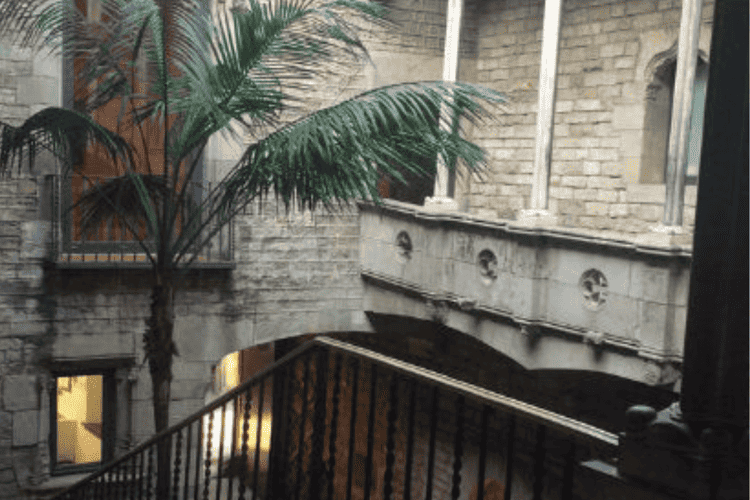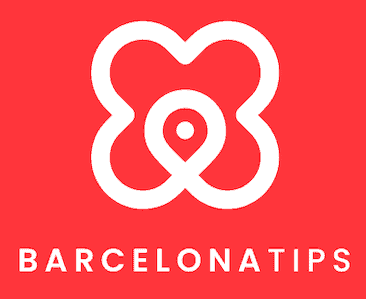Painter Pablo Picasso lived and studied in Barcelona. In the 1960s, a museum with works by the great master opened in the middle of the historic center. Today, the Picasso Museum is one of the most popular museums in the city. In this article you will find all the ins and outs about this highlight.
| Picasso Museum | Tickets, opening hours & public transportation |
|---|---|
| Tickets | Tickets online €14 |
| Adress | Carrer Montcada 15-23 (El Born) |
| Public transportation / subway | Metro: L4 Jaume I L1 Arc de Triomf Bus: 47, H14, H16, V15, V17 |
| Opening hours | Tuesday to Sunday: 09:00 – 20:00 Closed on Mondays Closed January 1, May 1, June 24 and December 25. January 5 from 10 a.m. to 5 p.m. December 24 and 31 from 10 a.m. to 2 p.m. Free: Thursday afternoons from 5 p.m. to 8 p.m. First Sunday of each month. Open house days: February 12, May 18 and September 24. |
Contents
- Plan your visit Picasso Museum in Barcelona
- Tickets, tours and guided tours
- Visit the Picasso Museum for free
- Practical info
- How do you get to the Picasso Museum?
- Address
- What to see and do during your visit to the Picasso Museum?
- Who was Picasso?
- History of the Picasso Museum in Barcelona
- Other Picasso spots in Barcelona
Skip the line! Picasso Museum Tickets
Tickets to the Picasso Museum are best bought in advance. The cost is €14 per adult. Under 18, admission is free, and over-65s and visitors between the ages of 18-25 pay €7.50. Tickets can be purchased here.
Plan your visit Picasso Museum in Barcelona
Málaga-born artist Pablo Picasso had a special connection to Barcelona. He studied at the art academy there, held his very first individual exhibitions and years later was given his own Picasso Museum. In addition to being a painter, he was a sculptor, graphic artist, illustrator and ceramist. There are a total of three Picasso museums in the world. The other two can be found in Paris and Málaga. The collection in Barcelona is the largest of all.
The Museu Picasso is one of the city’s most visited attractions and popular with art and culture lovers from around the world. The three-story museum consists of five medieval palaces in the El Born neighborhood and has no fewer than 35 rooms. The collection consists of works from the period 1890-1957.
The museum receives more than one million visitors a year, which is reflected by the long lines. So it is recommended that you buy your tickets in advance or book a tour that includes tickets. You can leave your coat and belongings in the checkroom for free on presentation of your admission ticket (you pay a euro deposit), lockers are available (a suitcase will not fit!).
The museum is large enough to wander around for hours. Expect to spend about two hours visiting the Picasso Museum. In addition to the permanent collection, temporary exhibitions are also held.
The Museu Picasso is centrally located in the old neighborhood of El Born, a 5-minute walk from metro stop Jaume 1 (yellow line) and is surrounded by charming stores, the basilica Santa María del Mar and many tapas bars. A visit to the Picasso Museum can easily be combined with a day (or part of a day) in the neighborhood of El Born. Here you can stroll, eat well, visit beautiful stores and take a look at the church of Santa María del Mar and the old market hall where today the museum El Born CCM is located.
When is the best time to visit the Picasso Museum?
At times when admission is free, it’s extra crowded and you trip over people. At other times there may be a long line, but it’s usually not too bad inside in terms of crowds, partly because it’s a fairly large museum. Early in the morning and at the very end of the day it tends to be quieter.
Tickets, tours and guided tours
Tip: Want to get the most out of your city break to Barcelona? Then the Barcelona City Pass might be for you. With this card you get a 10% discount to the Picasso Museum and tickets to the Sagrada Familia and Park Güell. All this together costs only €85.00.
Are you in Barcelona with a group and want to visit the Picasso Museum? Then contact me at info@barcelonatips.nl. I can often arrange discounts for groups of 10 to 35 people.
Visiting the Picasso Museum on your own
There are several ways to visit the Picasso Museum:
1. Basic entrance ticket
You can buy a skip the line admission ticket online in advance. The cost is €14 per adult. Up to 18 years of age, admission is free and over-65s and visitors between 18-25 pay €7.50. You can easily order your online tickets through this site.
2. Entrance ticket + audio guide
Buy your entrance ticket online in advance and purchase an audio guide with it on site. The price for the audio guides is €5; they come in ten different languages, including French, Spanish and English. When there are large crowds, sometimes the audio guides are all rented out, so you have to wait a while for one to become available.
3. Barcelona Card including entrance to Picasso Museum
The Barcelona Card provides free public transportation and admission to the Picasso Museum, among other attractions.
4. Articket: entrance to the six major art museums in Barcelona
Are you planning to visit multiple art museums in Barcelona? Then we recommend the ArTicket museum pass. For €35 you not only have access to the Picasso Museum, but also to the Centre de Cultura Contemporània de Barcelona (CCCB), the Fundació Antoni Tàpies, the Fundació Joan Miró, the Museu Nacional d’Art de Catalunya (MNAC) and the Museu d’Art Contemporani de Barcelona (MACBA).
Guided tour of the Museu Picasso
You can take a tour of the permanent collection on Sunday mornings at 11 a.m., accompanied by an English-speaking guide. You do need to book in advance for this. On Saturday afternoons at 3:30 p.m. guided tours of the temporary exhibitions are available in English.
It works like this:
1. Book the tour by email for up to six people: museupicasso_reserves@bcn.cat (please note that there are no tours at the Picasso Museum in August).
2. Be there at least ten minutes beforehand, otherwise they will give your place to people on the waiting list.
3. The meeting point is in front of the entrance at No.23 “Room Zero” (the Palau Finestres).
Visit the Picasso Museum for free
It is possible to visit the Picasso Museum free of charge at the following times/manner:
- Every first Sunday of the month and on certain holidays (Sant Eulàlia February 12 and 13, Museum Night on May 17, La Mercè on September 24 and on December 18,19 and 20), the museum is open for free. Just keep in mind that this means it is extra crowded. For those living near the museum, it is then almost impossible to do a quick errand, as the museum’s narrow street is usually packed with waiting people.
- On Thursday evenings from 5 p.m. to 8 p.m., the Picasso Museum is also free to visit.
- With the Barcelona Card, you can visit the Picasso Museum for free.
- Those who purchase an Articket can also enter for free with it.
Practical info
Prices
- Adult admission €14 (children under 18 get in free if accompanied by an adult). Buy tickets.
- Adult admission €35. Tickets with guided tour.
- Visitors aged 18-25 and over 65 €7.50.Buy tickets.
- With the Barcelona Card and the ArTicket you have free entry to the Picasso Museum.
Opening hours
Open Tuesday through Sunday: from 9 a.m. to 8 p.m.
Closed: Mondays (including holidays on Mondays), January 1, May 1, June 24 and December 25.
January 5 from 10 a.m. to 5 p.m. December 24 and 31 from 10 a.m. to 2 p.m.
Free hours: Thursday afternoons from 5 p.m. to 8 p.m. First Sunday of each month. Open house days Feb. 12, May 18 and Sept. 24.
Time slot
If you buy tickets online, you can choose from fixed visiting times. That means you have to decide in advance (when you reserve your tickets) what time you want to enter. Then make sure you are at the entrance on time as well. You can print your tickets or save them on your smartphone.
How do you get to the Picasso Museum?
Metro: It is recommended to use the subway. The nearest metro station is Jaume I (yellow line, L4). From here it is about a five-minute walk to the museum. Alternatively, you can take the red line to metro stop Arc de Triomf. Then it will take you about ten to fifteen minutes to walk.
Parking: For those coming by car, there is no parking at the museum! The nearest car parks are: Carrer Princesa, Passeig del Born / Plaça Comercial, Plaça de la Catedral, Avinguda Cambó and Via Laietana.
Walking: If you are staying in the center of Barcelona (around la Rambla, Gothic Quarter, La Barceloneta, El Born), you can walk to the Museu Picasso just fine. You won’t be on the road much longer than about 20 minutes.
Cycling: The Picasso Museum is also easy accessible by bicycle, within five to ten minutes from the center neighborhoods, but it is also cyclable (downhill) from Eixample. You can’t easily leave your bike on the street where the museum is located, but there are several parking facilities nearby.
Hop On Hop Off bus: The tourist bus does not stop in front of the Picasso Museum. The nearest stops are at the Pla de Palau or along Via Layetana. From there it is less than a ten-minute walk.
Address
Adress: Carrer Montcada 15-23 (El Born)
What to see and do during your visit to the Picasso Museum?
The museum collection
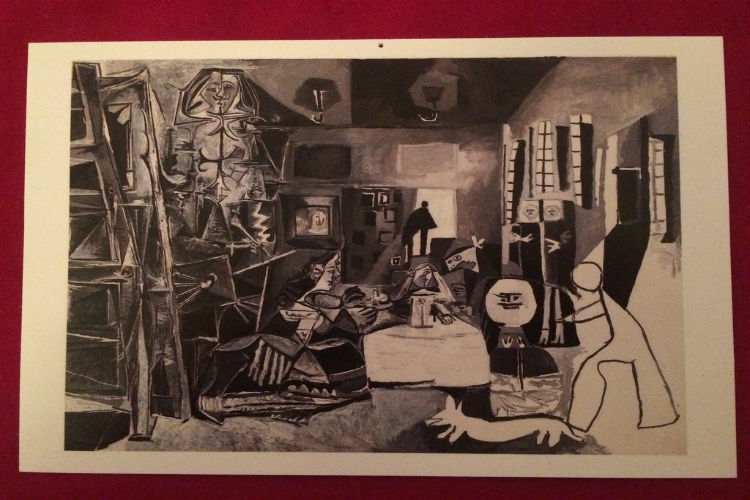
Postcard of Las Meninas, painted by Picasso in Cannes (1957)
The permanent collection is divided into sixteen rooms. Each room displays works from a particular period of Picasso’s life, and temporary exhibitions are also held regularly. With more than 4,250 works, the Picasso Museum in Barcelona has the most extensive collection of any Picasso museum. His early period (1891-1905) is especially well represented. The outstanding feature of the collection is Picasso’s interpretation of Velazquez’s Las Meninas, a series of 58 works in total.
Highlights at the Picasso Museum
These 5 highlights at the museum shouldn’t be missed:
- Science and Charity (1897), found in room 3
- Las Meninas series (1957), to be found in rooms 12, 13 and 14
- The madman (L’idiot, 1904), to be found in room 8
- The wait (Margot, 1901), to be found in room 7
- Still life (1901), to be found in room 7
The building itself
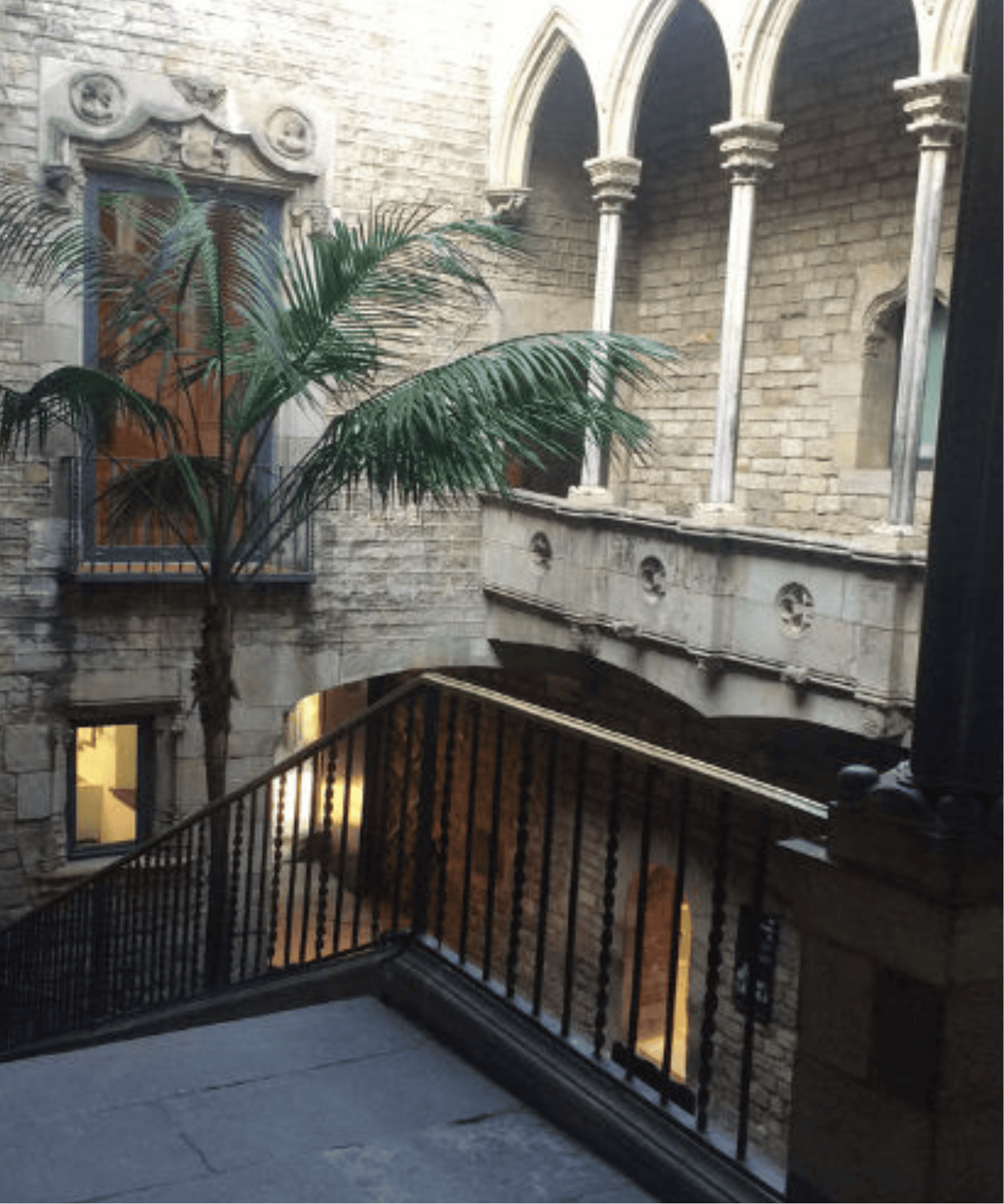
The building that houses the Picasso Museum is already worth seeing.
Today the Picasso Museum consists of five merchant houses, or rather palaces, from the 15th century: the Palau Aguilar, Palau Baró de Castellet, Palau Meca, Casa Mauri and Palau Finestres. The medieval entrance and beautiful patios are already magnificent.
The last major expansion was in the year 1999, when the Casa Mauri at number 21 and the Palacio Finestres at number 23 were added. The latter two spaces host the temporary exhibitions.
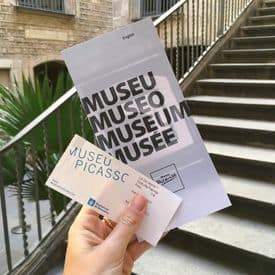
Also visit the Picasso Museum’s official website for more information.
Who was Picasso?
Pablo Picasso is considered the most influential artist of the twentieth century and, by the way, also with the longest name, he was officially called: Pablo Diego José Francisco de Paula Juan Nepomuceno María de los Remedios Cipriano de la Santísima Trinidad Ruiz y Picasso.
In 1895, the Ruíz-Picasso family moved to Barcelona and initially settled in where the restaurant 7 Portes now sits, on the outskirts of fishing district La Barceloneta. His father, who taught at the La Llotja art academy but always had the dream of living as an artist himself, recognized his son’s great talent early on. Pablo was accepted to the academy as a fourteen-year-old, but would never have completed his studies.
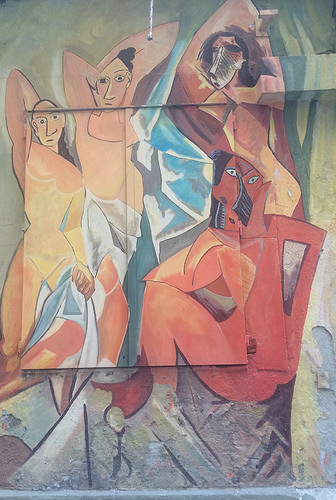
A year later, the family moved to carrer de La Mercè in the Gothic Quarter. In its side street, carrer de la Plata, you will find a wall drawing with a replica of Picasso’s famous painting Les Demoiselles d’Avignon (see photo on the left). On this spot, the artist had his first studio, together with Manuel Pallarés. This painting ushered in a new style of painting: cubism.
While in the studio, he painted Ciencia y Caridad, among others, on display at the Picasso Museum. He made this work after the death of his sister Conchita, who died of the disease croup just before moving to Barcelona, when she was seven. Her death made a deep impact on Picasso.
In fact, the painting does not show Conchita herself, nor would he ever paint her except for a drawing he made of her in pencil just before she died. This drawing hangs in the museum.
In 1904 Picasso left for Paris. But he would still have come regularly to Barcelona, the city he loved very much.
Picasso and his turbulent love life
Picasso was known for his many, passionate love affairs. He had several relationships in his life, especially with young, beautiful women who often worked as models for him. Every time a new muse appeared, you could see this reflected in his works; it was his creative fuel, so to speak.
It has been said about him that he enjoyed it when women fought over him and that he never felt guilty if he cheated on one with another. By the way, his greatest love seems to have been his dachshund Lump, who was the only one who had access to his studio (normally forbidden access even to his children).
Picasso’s different styles

Books about Picasso in several languages.
Blue (1901-1904)
This period began in the time after the suicide of his best friend, poet and painter Carlos Casagemas. It was a hard time for Picasso, marked by poverty and misery. Works from this time are made with blues, purples, greens and blacks. The figures are angular, somber and vulnerable.
Today they are Picasso’s most precious paintings but at the time of their creation he was unable to get rid of them. At the Picasso Museum in Barcelona you can see the permanent exhibition of the blue period.
Pink (1904-1906)
Everything begins to improve for the artist, he becomes more famous and he meets Fernande Olivier, a beautiful painting model. This fierce love has a great influence on his works and he begins to paint with pastel colors such as light blue but especially pink. Figures that appear frequently in these works are circus performers, he often went to the circus with Fernande.
Cubism (1906-1917)
In Paris, Picasso visits the Ethnological Museum and becomes deeply impressed by primitive African masks and totem figures. He begins to experiment with them in his own art and this leads to one of his most famous works Les Demoiselles d’Avinyó. He created it in the fall of 1906. Central theme was prostitution (in the Carrer d’Avinyó near his first studio, it was swarming with brothels).
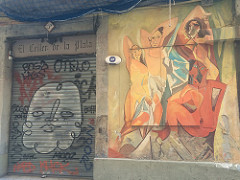
The painting anticipates Cubism, an innovative style he would develop with artist Georges Braque. Characteristic of Cubism, for example, is the fragmentation of the image and convergence of different points of view.
It also had a tighter and stricter character with thick layers of paint on top of each other. Cubist works are often somewhat reminiscent of a collage, a technique Picasso used a lot.
Classical (1917-1936)
World War I broke out, Picasso’s lover Eva Gouel died of throat cancer, and he fell into a deep depression. Many of his friends, including Georges Braque, had to serve in the military, and he felt lonely and abandoned without them.
In 1917, he went to Paris to design theater costumes and sets for a Russian ballet company. He began to study classical art and painted many works in Renaissance and Neoclassical styles. He married Olga Khokhlova, a Russian ballet dancer who introduced him to Parisian high society. They had a son together, Paul (incidentally, Picasso already had a daughter by then with a previous mistress).
They separated after ten years of marriage, but Picasso never wanted to officially divorce her because, according to French law, Olga would then be entitled to half of his assets. She died of cancer in 1955.
Surrealism (1925-1930)
This style became as important as Cubism. Picasso painted many surrealist canvases and iron-wire constructions during this period. In 1927, he met seventeen-year-old Marie-Thérèse Walter with whom he began an affair and soon became pregnant with daughter Maya. Olga found out, left Picasso and went to live in the south of France with their son Paul.
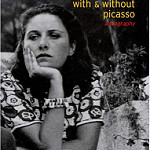
About a year later, just before the Spanish Civil War broke out, he met Dora Maar and decided that Dora and Marie-Thérèse should just fight over him. By then Dora was well known as a photographer, but was also a painter and often modeled for Picasso. He was fascinated by her “sad beauty.
When Picasso fell in love again with another woman and broke off the relationship with Dora, Dora literally went mad with grief and was even admitted to a mental institution. She reportedly had no more love affairs until her death in 1997, when she was eighty-nine, and lost herself in the Catholic faith. After Picasso, only God remained.
Abstract (from the 1940s onward)
This period is Picasso’s most famous period and was called the “Picasso style”. He began to work more and more abstractly and made many portraits of Dora.
In 1943, he fell madly in love with Françoise Gilot with whom he had two children: Claude and Paloma. After Gilot had left Picasso for years, their children competed to have their father’s last name, which was especially convenient for Paloma who eventually became a famous fashion designer.
Last period
In the 1950s, he met Jacqueline Roque whom he married in 1961. He made hundreds of portraits of her and continued to paint her until his death, in an increasingly abstract style. These works are all characterized by a feline face and exaggerated neck. Her dark eyes and high cheekbones symbolize Picasso’s style.
In the last years of his life, he withdrew from public life but continued to paint until his death in April 1973; he died of pneumonia. After his death, Roque got into a complicated, legal battle with Picasso’s children over the inheritance of the world-famous Picasso’s oeuvre. She committed suicide in 1986.
History of the Picasso Museum in Barcelona
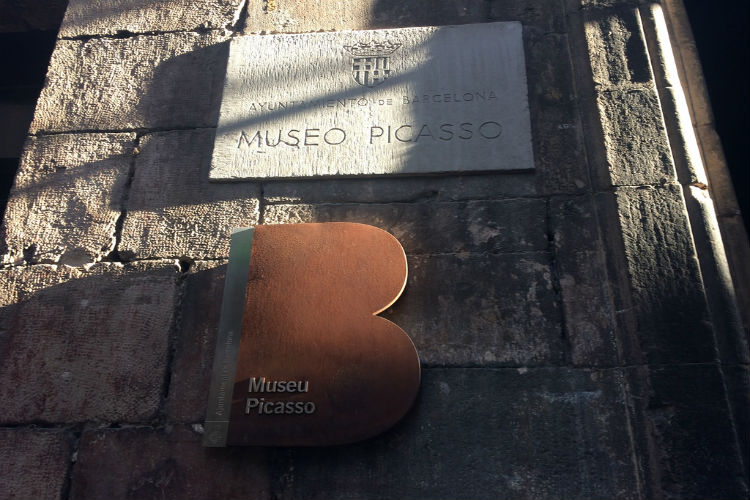
Front of the Picasso Museum in Carrer de Montcada
When the museum opened on March 9, 1963, Spain was still in the midst of Franco’s dictatorship. Pablo Picasso had vowed that as long as Franco ruled, he would not set foot on Spanish soil and therefore was not present at the opening of his museum, which, in fact, he was closely associated with.
The name of the museum housed in a former palace called Palacio Aguillar during the Franco period was Colección Sabartés, named after his close friend Jaume Sabartés who donated his personal collection to the museum on Carrer de Montcada. Picasso’s other works came from other art museums in the city, including the famous painting El Arlequín and many drawings, etchings, lithography and posters.
In 1970 Picasso donated the entire collection owned by his family with no less than 921 works including many oil paintings and many drawings he made as a child and young man. In the early 1980s, Picasso’s widow Jacqueline Roque donated a number of Picasso’s distinguished works, including ceramic sculptures and the painting La mujer de la cofia.
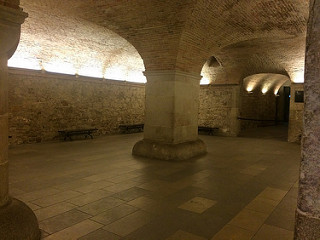
Today the Picasso Museum consists of five merchant houses from the fifteenth century. The last major expansion was in the year 1999, when the Casa Mauri at number 21 and the Palacio Finestres at number 23 were added. The latter two spaces host the temporary exhibitions.
Personal tip
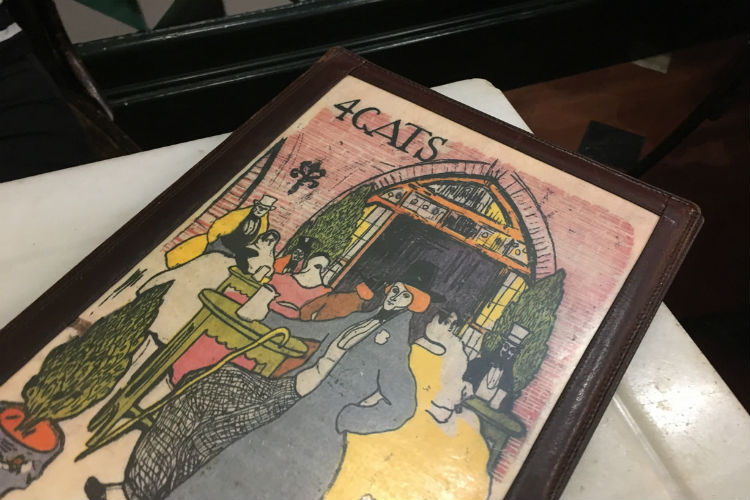
After your visit to the Picasso Museum, have a drink or dinner at Els 4 Gats restaurant in the Gothic Quarter (ten-minute walk). This is where the young Picasso himself liked to come for a drink. Antoni Gaudí and writer Hemmingway were also regulars here. Inside, it is full of pictures of Picasso himself and his contemporaries. The menu (see photo) was designed by Picasso and has been used for about 100 years. Woody Allen shot some scenes here in 2007 for his film Vicky Cristina Barcelona. Address: Carrer Montsó 3.
Other Picasso spots in Barcelona
Art Academy
Before Picasso came to Barcelona in 1895, he lived in Málaga. Here he developed his talent for painting. His father, who was also an artist by the way, at one point got a job in Barcelona teaching at “La Llotja” art school. Pablo Picasso was 13 years old when the family moved. Picasso later attended this school as well.
Home
The Picasso family lived in Barcelona between the neighborhood of El Born and La Barceloneta, in a residence in the Porxos d’en Xifre building. It is said that Picasso often visited the terrace and the view is said to have inspired his first works.
Café Picasso
Els Quatre Gats was a meeting place for artists, architects and designers in the era of modernism. Pablo Picasso was also a regular visitor there. This was also the location for his very first solo exhibition. Picasso also designed the menus for the café-restaurant. Besides Els 4 Gats, he also liked to visit Bar Marsella (El Raval) and Bar La Plata (Barri Gòtic). Both of these cafes also still exist and are well worth a visit.
Picasso streetart
What many do not know is that at Architect’s College directly across from the Roman walls on Plaça Nova in front of the cathedral, there is also a huge work of Picasso’s art, just out in the open. Also in the Museu Nacional d’Art de Catalunya (MNAC) are works by Picasso, including Woman in Hat and Fur Collar, from 1937.
Art Studio
On the street where Bar La Plata can be found, the Carrer de la Plata (from which the bar gets its name), Picasso’s first art studio was located at number 4 or 5. Picasso was only 14 at the time. The owners of the former tapas bar (number 3) down the street, had a life-size reproduction of one of Picasso’s most famous paintings made on their facade: Les Demoiselles d’Avignon. He took the inspiration for this work from the nearest street Carrer d’Avinyó, which was home to many brothels at the time. The women in the work are prostitutes.
Later Picasso had studios at Carrer Nou de La Rambla 10, in El Raval, among other places. There Picasso shared premises with sculptor Ángel Fernández de Soto and painter Josep Rocarol. Pablo Picasso also worked in Carrer de la Riera de Sant Joan, number 17. The last studio (1904) in Barcelona where Picasso worked was lent to him by sculptor Pau Gargallo. In addition to the two, artist Isidre Nonell also used the studio.
Ramón Casas
The Sala Parés, Carrer de Petritxol 5, hosted Picasso’s first exhibition in collaboration with Ramon Casas. Sala Parés is one of the oldest art galleries in the world.
